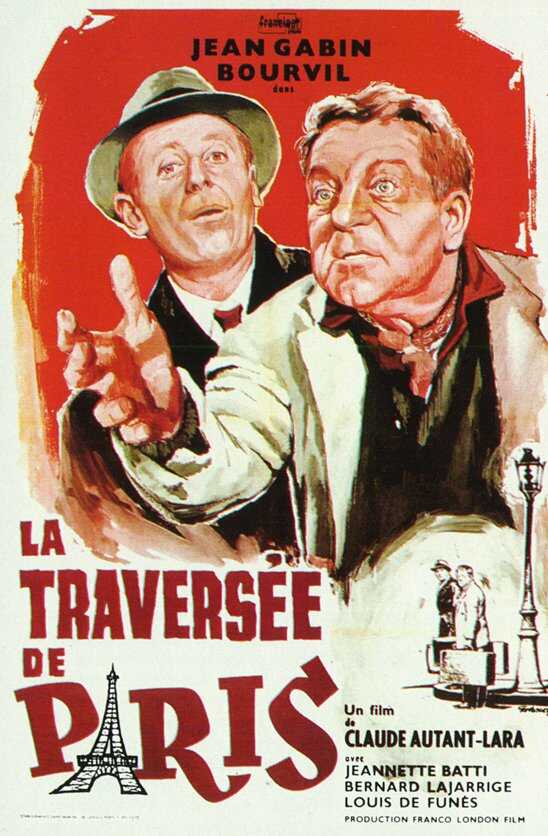What’s derisive in the American title A Pig Across Paris (now playing at Film Forum) drives home the bitterness hidden in the original French title La Traversee de Paris (Crossing Paris). This 1956 release hasn’t been shown in the U.S. in more than 50 years probably because its satire on French propriety doesn’t fit the romantic image of French Resistance courage. The audacity of director Claude Autant-Lara and screenwriters Jean Aurenche and Pierre Bost–filmmakers not known for their daring– is what’s most surprising about this tale of the Parisian black market during the 1940s German Occupation.
Two Frenchmen, Marcel (Bourvil) and Grandgil (Jean Gabin), come together in this time of scarcity to smuggle a butchered pig across the city, carrying the carcass in four valises under the noses of German and French police. They team-up as class clowns–Marcel’s desperate working man and Grandgil’s angry bourgeois. The variety of scared, anxious folk they meet depicts the whole of French citizenry. (What a post-9/11 episode of The Simpsons derided as “Cheese-eating surrender monkeys.“) It’s probably the darkest, least boastful portrait of French people since Henri-Georges Clouzot’s 1946 Le Corbeau (about paranoia overtaking a small Occupied village). Autant-Lara shoots most of it in harsh b&w, almost neorealist for daytime but primarily in shadowy nighttime. It’s a noir comedy, conveying the general displeasure–the atmospheric malaise–that defines a society almost conquered by its easy corruption and defeatism.
Instead of Resistance Era chic, Autant-Lara‘s perspective is defined by Gabin’s “Spinelesness must be in fashion.” It is rare to see a film that confronts a less-than-heroic political moment without giving in to miasma. (The facile certainty about Left or Right.) The deliberately pedestrian pace of this comedy is proof of suppressed optimism. Looking back almost a decade after Occupation, Autant-Lara recalls how France nearly succumbed (the most visually resplendent scenes are ironic: Gestapo headquarters is an opulent Louis XV mansion).
A Commander in the Feldgendamerie says “In every Frenchman dozes a pig, maybe in every human.” That’s Autant-Lara facing the worst in his countrymen. The observation “You can go a long way with a coward” is almost Satrean in its despair. That’s the profundity beneath the comedy–Marcel and Grandjil’s journey to the end of the night, trailing pools of blood, is bolder than hindsight protestations of defiance. Ambivalent French rationalism maintains a seesaw balance of pride and disgust.
Bourvil’s clerk-like sensibility contrasts Gabin’s bumptious virility. It is Gabin, of course, who as the painter Grandjil carries the brotherhood tradition of Renoir’s La Grande Illusion. Moments such as an old French hooker laughed at by a Nazi soldier, a husband and wife watching a silhouetted stop-and-frisk pantomime convey the depth of Occupation’s ambiguous sympathy and terror. These complications are easily ignored during an escapist period with oversimplified political attitudes ideas about patriotism and loyalty. (It’s the opposite sentiment of John Ford’s The Informer and richer than Billy Wilder’s Stalag 17.) Francois Truffaut only touched on these complications in his Resistance film The Last Metro (now recognizable as a kind of mea culpa for his critical attacks on Autant-Lara, Aurenche and Bost, youthfully misunderstanding what they knew about the French character).
It’s a rare comedy indeed that ends as movingly as A Pig Across Paris: With civilization restored along with France’s industry, Marcel and Granjil meet again: class difference intact but with profound memories that bind them.
Follow Armond White on Twitter at 3xchair

